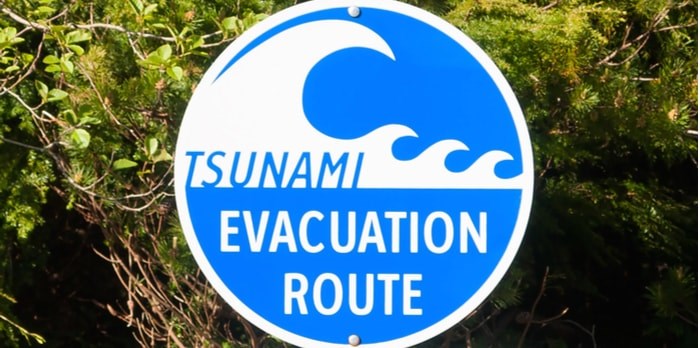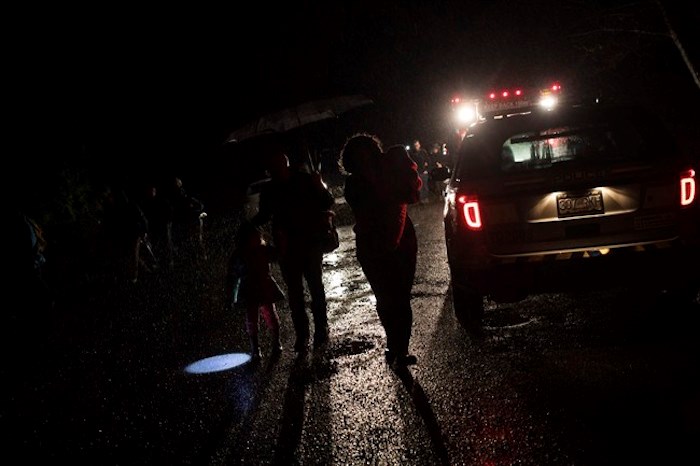A tsunami warning issued for coastal British Columbia was cancelled Tuesday morning after people living along parts of the province's coast evacuated to higher ground when a powerful earthquake struck off Alaska.
 Tsunami sign/Shutterstock
Tsunami sign/Shutterstock
Residents in some coastal communities were woken by warning sirens shortly after the quake with a magnitude of 7.9 struck at about 1:30 a.m. Pacific time. The quake was centred 278 kilometres southeast of Kodiak in the Gulf of Alaska at a depth of about 10 kilometres.
Public Safety Minister Mike Farnworth said several communities activated their emergency plans and evacuated those at risk as the provincial emergency co-ordination centre and five regional operations centres were also mobilized.
"Although the tsunami warning was eventually suspended, this event demonstrates that coast warning systems do work," he said in a statement.
"In the event of a future tsunami warning, stay calm, stay safe; listen to your local officials and head to higher ground."
The tsunami warning sent officials scrambling around Greater Victoria.
At 4:30 a.m., Victoria Mayor Lisa Helps tweeted that she was at the emergency operations centre and people within two blocks of the water were being evacuated.
In Saanich, where cars flocked to the high ground on Mount Tolmie, police began going door-to-door to alert residents of low-lying properties. An emergency evacuation centre was set up in the Gordon Head Recreation Centre.
Similar centres were established at the Oak Bay Recreation Centre and at St. Mary’s Anglican church in Metchosin.
 Tofino residents and visitors leave the community centre after the tsunami warning ends, on Tuesday, Jan. 23, 2018. A tsunami warning issued for coastal British Columbia was cancelled Tuesday morning after people living along parts of the province’s coast evacuated to higher ground when a powerful earthquake struck off Alaska. THE CANADIAN PRESS/Melissa Renwick
Tofino residents and visitors leave the community centre after the tsunami warning ends, on Tuesday, Jan. 23, 2018. A tsunami warning issued for coastal British Columbia was cancelled Tuesday morning after people living along parts of the province’s coast evacuated to higher ground when a powerful earthquake struck off Alaska. THE CANADIAN PRESS/Melissa Renwick
The West Shore RCMP cleared parked vehicles away from the Esquimalt Lagoon and blocked the road to Fort Rodd Hill. Residents of houses along the lagoon were notified of the warning.
Esquimalt warned residents of low-lying areas to evacuate, advising them that the Esquimalt Recreation Centre was open to them.
In Port Alberni, which was devastated by a tsunami in 1964, a disaster siren roused residents from their beds at 3 a.m.
Patricia Leidl, communications director with Emergency Preparedness BC, said there was a three centimetre wave and a 15 centimetre rise in sea level hours after the quake at Tofino on the west coast of Vancouver Island.
The tsunami warning covered B.C.'s north coast, Haida Gwaii, the west coast of Vancouver Island, the central coast and northeast Vancouver Island, and along the Juan de Fuca Strait.
People were told to evacuate inland or to higher ground, or move to an upper floor of a multi-story building, depending on individual situations.
Dan Banks, a public works employee in Tofino, said residents in low-lying areas, including resorts on along the beach, were told to go to higher ground.
"It's tsunami protocol, everybody is going to high ground and evacuating the low-areas like they are supposed to," he said, adding people also gathered at a community hall.
Gillian Der, a University of British Columbia geography student who is studying in Queen Charlotte on Haida Gwaii, said she didn't feel the earthquake.
"I don't think any of us felt anything," she added.
"I just heard the fire trucks going around, honking their horns and on the loud speaker saying there is a tsunami warning. It was very apocalyptic. So I was just running up the street to the muster station, up the big hill."
The last devastating tsunami to hit B.C. was 54 years ago in Port Alberni after a 9.2 earthquake off Alaska. Two waves gathered force as they raced up the funnel-like Alberni Inlet in March 1964, hitting the city with forces that swept away houses and vehicles, but caused no deaths.
Scientists in Japan, and Vancouver Island First Nations, have gathered accounts of a huge earthquake and tsunami in January 1700 that wiped out communities and killed thousands of people. A wave the height of a four-storey building hit the east coast of Japan nine hours after the original earthquake off the B.C. coast.
People in Alaska received warnings Tuesday from the National Weather Service sent to cellphones that said: "Emergency Alert. Tsunami danger on the coast. Go to high ground or move inland."
Lt. Tim Putney of the Kodiak Police Department said the earthquake woke him up out of a dead sleep, and he estimates it shook for at least 30 seconds.
"I've been Kodiak for 19 years that was the strongest, longest lasting one I've ever felt," he told The Associated Press.
The Alaska Earthquake Information Center said the quake was felt widely in several communities on the Kenai Peninsula and throughout southern Alaska, but it also had no immediate reports of damage. People reported on social media that the quake was felt hundreds of kilometres away, in Anchorage.
Keith Perkins, who lives in the southeast Alaska community of Sitka, arrived at the high school early Tuesday morning, after an alarm on his cellphone alerted him of the tsunami warning. He said the city's sirens also went off later.
— with a file from Jack Knox
Given the magnitude of the earthquake, Perkins said he thought it best to head to the school, the tsunami evacuation point, even though in the past he felt his home was at a "high-enough spot."
"I figured I'd probably just better play it safe."
— With files from The Associated Press
![]()


